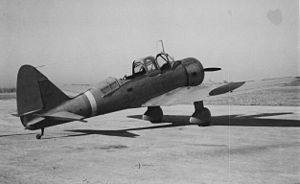avia.wikisort.org - Aeroplane
The Tachikawa Ki-36 (named Ida in Allied reporting code) was a Japanese army co-operation aircraft of World War II. It was a two-seat, low-wing monoplane with a single piston engine and fixed, tailwheel-type undercarriage.
| Ki-36 | |
|---|---|
 | |
| Role | Two-seat Army Co-operation Aircraft |
| Manufacturer | Tachikawa Aircraft Company Ltd |
| First flight | 20 April 1938 |
| Primary users | Imperial Japanese Army Air Force Royal Thai Air Force |
| Produced | 1938 - 1944 |
| Number built | 1,334 |
| Variants | Tachikawa Ki-55 |
Design and development
The prototype, fitted with a 450 hp (336 kW) Hitachi Army Type 98 Ha-13 engine, first flew on 20 April 1938. Having outperformed the Mitsubishi Ki-35 in comparative trials, the Ki-36 was designated the Army Type 98 Direct Co-operation Aircraft and ordered into production in November 1938. Production ended in January 1944 after a total of 1,334 Ki-36 had been built (Tachikawa 862 and Kawasaki 472).[1]
Operational history
The Ki-36 first saw action in China where it saw success. Later, in the Pacific, it proved excessively vulnerable to opposing fighters. It was thereafter redeployed to the safer theater of China. Towards the end of the war, the Ki-36 was employed as a kamikaze aircraft with a bomb of 500-kg (1,102-lb) fitted externally.[2]
Variants
- Ki-55: Two-seat advanced trainer version.
- Ki-72: An evolved version with a 600-hp (447-kW) Hitachi Ha-38 engine and retractable undercarriage. Not built.
Operators

 People's Republic of China
People's Republic of China
- Chinese Communist Air Force operated two captured aircraft postwar as trainers until their retirement in early 1950s.
 Indonesia
Indonesia
- Indonesian People's Security Force
 Japan
Japan
- Imperial Japanese Army Air Force
 Thailand
Thailand
- Royal Thai Air Force
Specifications (Ki-36)
Data from Japanese Aircraft of the Pacific War,[2] The Concise Guide to Axis Aircraft of World War II[3]
General characteristics
- Crew: 2
- Length: 8 m (26 ft 3 in)
- Wingspan: 11.8 m (38 ft 9 in)
- Height: 3.64 m (11 ft 11 in)
- Wing area: 20 m2 (220 sq ft)
- Airfoil: root: NACA 23014; tip: NACA 23006[4]
- Empty weight: 1,247 kg (2,749 lb)
- Gross weight: 1,660 kg (3,660 lb)
- Powerplant: 1 × Hitachi Ha13a (Army Type 98 450hp Air Cooled Radial) 9-cylinder air-cooled radial piston engine, 380 kW (510 hp) for take-off
- 350 kW (470 hp) at 1,700 m (5,577 ft)
Performance
- Maximum speed: 348 km/h (216 mph, 188 kn)
- Cruise speed: 235 km/h (146 mph, 127 kn)
- Range: 1,235 km (767 mi, 667 nmi)
- Service ceiling: 8,150 m (26,740 ft)
- Time to altitude: 3,000 m (9,843 ft) in 6 minutes 39 seconds
- Wing loading: 83 kg/m2 (17 lb/sq ft)
- Power/mass: 0.23 kW/kg (0.14 hp/lb)
Armament
- Guns: one fixed, forward-firing 7.7 mm (0.303 in) Type 89 machine gun, one flexible 7.7 mm (0.303 in) Type 89 machine gun in the rear cockpit.
- Bombs: up to 350 kg (772 lb) external bombload
See also
Related development
Related lists
- List of military aircraft of Japan
References
Citations
- Francillon 1979, p. 254.
- Francillon 1979, p. 253.
- Mondey 1996, p. 246.
- Lednicer, David. "The Incomplete Guide to Airfoil Usage". m-selig.ae.illinois.edu. Retrieved 16 April 2019.
Bibliography
- Francillon, René J. (1979). Japanese aircraft of the Pacific War. London: Putnam. ISBN 0-370-30251-6. OCLC 6124909. (new edition 1987 by Putnam Aeronautical Books, ISBN 0-85177-801-1.)
- Mondey, David (1996). Axis aircraft of World War II. London: Chancellor Press. ISBN 1-85152-966-7. OCLC 46705109.
- Soumille, Jean-Claude (September 1999). "Les avions japonais aux coleurs françaises" [Japanese Aircraft in French Colors]. Avions: Toute l'Aéronautique et Son Histoire (in French) (78): 6–17. ISSN 1243-8650.
External links
На других языках
[de] Tachikawa Ki-36
Die Tachikawa Ki-36 (alliierter Codename Ida) war ein Verbindungsflugzeug der Kaiserlich Japanischen Heeresluftstreitkräfte während des Zweiten Weltkriegs. Die Ki-36 war ein einmotoriger zweisitziger Tiefdecker mit nicht einziehbarem Spornradfahrwerk.- [en] Tachikawa Ki-36
[fr] Tachikawa Ki-36
Le Tachikawa Ki-36 est un avion d'attaque légère japonais de la Seconde Guerre mondiale. Certains exemplaires furent utilisés pour des attaques suicides. Son nom de code allié était Ida.[it] Tachikawa Ki-36
Il Tachikawa Ki-36 (立川 キ36 Tachikawa ki sanjūroku?), indicato anche Aereo da ricognizione per il supporto ravvicinato Tipo 98 (九八式直接協同偵察機 Kyūhachi-shiki chokusetsukyōdō teisatsuki?) in base alle convenzioni allora vigenti, e al quale venne assegnato dagli alleati il nome in codice Ida[3] fu un aereo da ricognizione monomotore, monoplano ad ala bassa sviluppato dall'azienda aeronautica giapponese Tachikawa Hikōki KK nei tardi anni trenta e prodotto, oltre che dalla stessa, anche dalla Kawasaki Kokuki Kogyo, la divisione aeronautica della Kawasaki Heavy Industries, fino alla prima metà degli anni quaranta.[ru] Tachikawa Ki-36
Ki-36 —Армейский тактический разведчик/легкий штурмовик, одномоторный моноплан цельнометаллической конструкции.Другой контент может иметь иную лицензию. Перед использованием материалов сайта WikiSort.org внимательно изучите правила лицензирования конкретных элементов наполнения сайта.
WikiSort.org - проект по пересортировке и дополнению контента Википедии